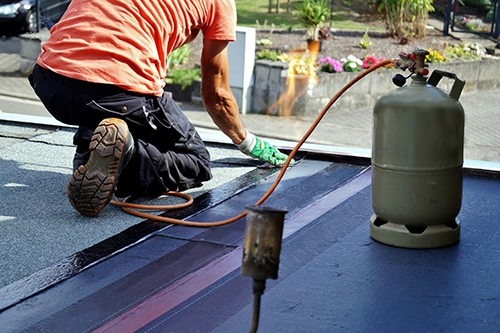- About Us
- Services
- Blog
- Contact
Need a quote?
Given the city’s age and range of architectural styles, it’s fair to say that every day is different when it comes to commercial roofing services in London.
Add to that the number of newer builds made from more modern construction materials, and it’s easy to see why experience is so important when picking a roofing company in London.
Here at Environ roofing, we have a huge amount of experience across a variety of residential and commercial roofing services in London. Today we’d like to give a quick overview of the differences between commercial and residential projects, as well as the steps we take to provide the best possible services to our clients.




First things first, no matter the project, we need to have a clear understanding of the requirements.
All roofs have to be durable and built to stand up to the environment but commercial roofing often spans a much larger surface area than residential roofing. And then you have extra considerations, such as runoff.
Generally speaking, residential roofing in London will feature a sloped roof, allowing rain to pour down into the gutter, but for commercial roofing, things can get a little trickier. Commercial roofing in London often has to be specially tailored towards the building in question in order to avoid major problems such as water pooling. It’s our job to look at the requirements, and decide how to best work around them.
It’s also important to consider materials. With residential roofing, material considerations are often more geared towards aesthetics while commercial roofing, by its nature, has to be a little more practical. Many commercial buildings also require stricter temperature control, and sometimes access points.
That’s not to say residential buildings don’t have their challenges too! Because so many of London’s buildings are older, we often need to find materials that match what was there before, and that can involve a bit of back and forth, but nothing beats the feeling of getting the perfect match for a period home!
We have two major strengths at Environ Roofing that give us the versatility to work on almost any roofing project.
The first is experience and knowledge, whether it’s a huge roof on a commercial building or a small repair on a residential one, we guarantee the highest quality work performed in the timeframe you need.
Our second biggest strength is our customer service. No matter how big or small the job is, we always go above and beyond to give our customers the best experience. Just check our testimonials for proof.
Whether you’re looking for residential roofing London or commercial roofing London, we’ve got you covered.
It depends on the construction, but the minimum weight a flat roof must be capable of bearing is 300lbs. This refers to a concentrated weight where a load is positioned on just one area of the roof. So, for example, a commercial flat roof can approximately support a 300lb HVAC unit in a 2.5×2.5ft single space.
If you opt for a flat roof anywhere on your property, remember that it comes with a need for proper maintenance. Low-slope roofing London-wide should be checked every six months or so, or after spells of bad weather, to spot any signs of damage. No matter how small, these should be addressed before they escalate. Remove any debris (leaves, twigs and so on) regularly to avoid these blocking the gutters and allowing water to pool and stand on the roof.
If there are trees in the close vicinity, keep them cut back to reduce the amount of foliage that falls on your flat roof. And check internally for signs of moisture, dampness or water damage on a regular basis. Spotting problems early means resolving them will be cheaper in the long run.

Building a flat roof can be done in three ways. The simplest and most cost-effective choice for levelled roofing London-wide is to construct a warm roof where a roofing membrane is placed over the insulation that keeps the timber structure warm. Another option is to create a cold roof where insulation is positioned between the rafters under the ply roof covering. This is commonly applied to flat-roofed extensions.
The third method is the hybrid roof that contains diverse elements. Their designs require a gap of ventilation above a warm roof to prevent excess moisture within the roof structure.
If you’re looking for flat roofing local contractors, don’t just select the first firm you come across. Find a roofing company that’s been in business for a while and can demonstrate a good track record in installing, repairing, and replacing flat roofs specifically. Ask for recommendations from your own network or from a local trade association. If you need refurbishment work done to 50% or more of your roof, you’ll need a roofing contractor who can self-certify their work under the Competent Person Scheme. Otherwise, the Building Control department at your local authority will need to approve the job before it begins.
Ask whether they are covered by liability insurance and how long they’ll guarantee the work they will carry out. And never just opt for the cheapest quote unless you’re quite sure they’re the best company for the job. You can’t afford to compromise on your roof as the structural integrity of your property depends on it.
Ensuring your flat roof will comply with building regulations before installation can save property owners time, money and stress. First, the roof must have a slope of around 1:80, with water draining away to one or two roof edges. Waterproofing must be extended up to the adjacent walls with at least 150 mm from the surface of the roof.
Contractors must install ventilation in cold roofs. For warm roofs, the deck must be bonded with a VCL. The roof should have the capacity to withstand strong winds and be sturdy enough to take an individual’s weight. Finally, check whether planning permission is needed. Typically, this is only required if you live in a conservation area or a listed building, or are making significant changes to an existing roof.
If you’re looking for top roofing solutions at competitive rates, check out our range of roofing services at Environ Roofing Company London. To get started, call one of our representatives today!

